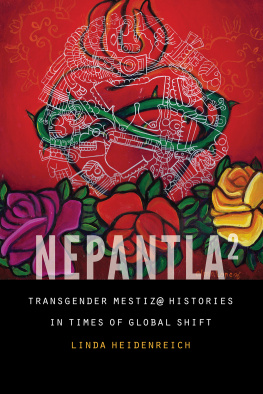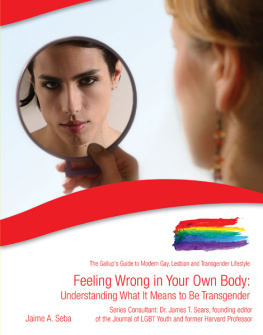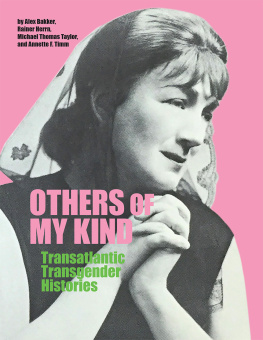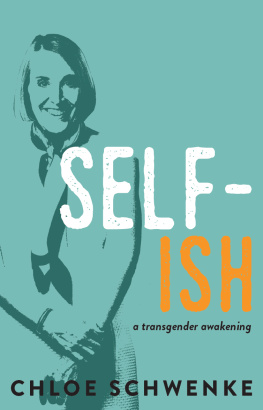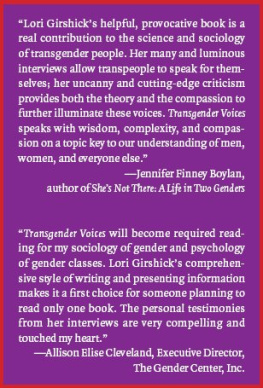
This queer Chicanx history project is everything such a project should be: a brilliant analysis with fresh and illuminating ideas and approaches, an unearthing of hidden trans stories, and an intellectual exploration of trans mestiz@ identity.
Norma E. Cant, Norine R. and T. Frank Murchison Professor of the Humanities at Trinity University
Nepantla Squared is a welcome and refreshing contribution to intersectional trans, queer, and feminist histories of resistant gender. Linda Heidenreich provides a new depth of context to famous stories of anti-trans violence and resistance, like those of Jack Garland and Gwen Araujo, showing how these are stories about colonialism, capitalism, and neoliberal economic policy. Heidenreichs writing is pleasurably readable and the book is insightful and original.
Dean Spade, author of Normal Life: Administrative Violence, Critical Trans Politics, and the Limits of Law
Historical, materialist, and timely, this book adds new important ways of understanding trans in different historical moments and through nonbinary mestiz@ indigenous roots and routes in the Americas.
Kale Bantigue Fajardo, author of Filipino Crosscurrents: Oceanographies of Seafaring, Masculinities, and Globalization

Expanding Frontiers: Interdisciplinary Approaches to Studies of Women, Gender, and Sexuality
Series Editors:
Karen J. Leong
Andrea Smith
Nepantlasquared
Transgender Mestiz@ Histories in Times of Global Shift
Linda Heidenreich
University of Nebraska Press | Lincoln
2020 by the Board of Regents of the University of Nebraska
Cover designed by University of Nebraska Press; cover image: Sacred Heart of Coyolxauhqui by Alma Lopez 2012.
Acknowledgments for the use of copyrighted material appear in , which constitute an extension of the copyright page.
All rights reserved.
Library of Congress Cataloging-in-Publication Data
Names: Heidenreich, Linda, 1964 author.
Title: Nepantla squared: transgender mestiz@ histories in times of global shift / Linda Heidenreich.
Description: Lincoln: University of Nebraska Press, [2020] | Series: Expanding frontiers: interdisciplinary approaches to studies of women, gender, and sexuality | Includes bibliographical references and index.
Identifiers: LCCN 2020010787
ISBN 9781496213402 (hardback)
ISBN 9781496221964 (paperback)
ISBN 9781496222398 (epub)
ISBN 9781496222404 (mobi)
ISBN 9781496222411 (pdf)
Subjects: LCSH : Transgender peopleHistory. | MestizosHistory. | MestizajeHistory. | Feminist theory. | Queer theory.
Classification: LCC HQ 77.9 . H 438 2020
DDC 306.76/809dc23
LC record available at https://lccn.loc.gov/2020010787
The publisher does not have any control over and does not assume any responsibility for author or third-party websites or their content.
With gratitude to
Dolores del Carmen Heidenreich
Karen Gallaghar
Guadalupe Tonantzn
Contents
Table
For most scholars the research and crafting of a monograph can take years, weaving in and out of the many challenges of their lives. So it was for Nepantla2. This journey began with research into the life of a young transgender woman, Gwen Amber Rose Araujo, whose life was cut short due to the fear and hate of peers, also young, who had learned to perform their masculinity through violence. In trying to make sense of a world that could produce so much violence, by and against young people, the project grew and evolved, as did the questions driving it. The vectors critical to understanding our violent world multiplied and wove themselves into the text that you hold in your hands: one about economic shifts, about gender, about the ancient philosophers of Anahuac who gifted us the philosophy of nepantla, about labor activists and Zapatistas, and about a fierce Chicana feminist by the name of Gloria E. Anzalda.
And so I wrote, and as I wrote my perspectives on life, gender, and the universe shifted and fluxed. Friends died, elders aged, sobrinos birthed babies, presidential elections came and went, and the earth continued to warm. As someone who identifies as queer, mestiz@, materialist, and Catholic, I believe that my history and all my selves play a critical role in shaping my lensmy ability to understand our past and to dream and shape both the present and the future. This work, then, emerged from a world and life of motion-change, and is very much about change: Californias economic and cultural shifts with the emergence of monopoly capitalism, and the more recent economic and cultural shifts bringing us into the epoch of global capitalism.
Earlier versions of chapters 2 and 4 were published as journal articles. Thus, I thank the Journal of Chicana/Latina Studies for allowing me to use material from Learning from the Death of Gwen Araujo?Transphobic Racial Subordination and Queer Latina Survival in the Twenty-First Century (vol. 6, no. 1 [Fall 2006]: 5086), and its editorial staff and readers for their incredible insights and editing of that earlier work. Similarly, an earlier iteration of chapter 4 appeared as Jack Mugarrieta Garland: A Queer Mestiz@ in the American West, in Lilith: A Feminist History Journal 21 (August 2015): 6577, with generous support and insights from their staff and readers. The editors of these two journals continue to promote gendered, scholarly work that not only allows but also encourages historians and other humanities scholars to think outside the box.
As much as writing a monograph is a journey, it is not one that we take alone. For the historian, archives are the water of life, and several of them were critical to the making of Nepantla2. The GLBT Historical Society, in San Francisco, California, is a treasure trove for anyone researching our histories. The welcoming and supportive staff there made the early research of this project joyful. Similarly, the staff at the San Francisco History Center, in the main branch of the San Francisco Public Library, consistently went beyond the standard commitment to helping patrons find sources. At the San Francisco History Center it was refreshing to see archivists who treated everyone who came through their doors with the utmost respect, valuing everyones projectnot just those who seemed to be more important. Later in the project it was the staff at the Nettie Lee Benson Latin American Collection who created an atmosphere welcoming to scholars of all ages. There were, of course, many other sites critical to making this work a reality, and while I cannot list them all here, I can express my gratefulness that so many of the places where I conducted the research for this work were welcoming. To have a world in which all of us can shape our narratives, we must have archivists, such as those at the places listed above, who welcome all who come searching for answers.
I live and work at a university on the Washington-Idaho border, amid fields of wheat, lentils, and chickpeas on land that if not for colonizing wars would still be in the hands of the Palus and the Nimiipuu people. Grants from Washington State University, my home institution, in the form of an initiation grant at the beginning of the project and a block grant when I needed to go back to California to hit up one last archive, made this work possible. Noel Sturgeon was, in the early years of the project, absolutely the most supportive chair a scholar could ever hope for. My colegas in the Department of Womens Studies made our space a productive and supportive one: Judy Meuth, Marian Sciachitano, Pam Thoma, and Nishant Shahanithey all rock. I thank them for their collaboration on the important stuff, especially movies and birthdays and bowling. Thanks to Nishant Shahani for input on many of these chapters and for keeping me honest with our weekly writing time. And our manuscripts collection staff, especially Trevor Bond, again made time to help me with images.
Next page
